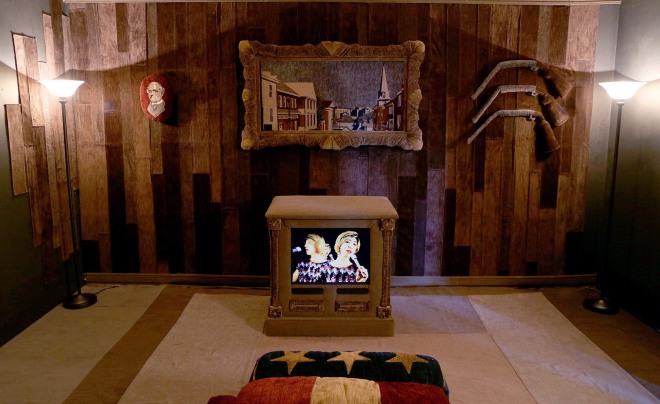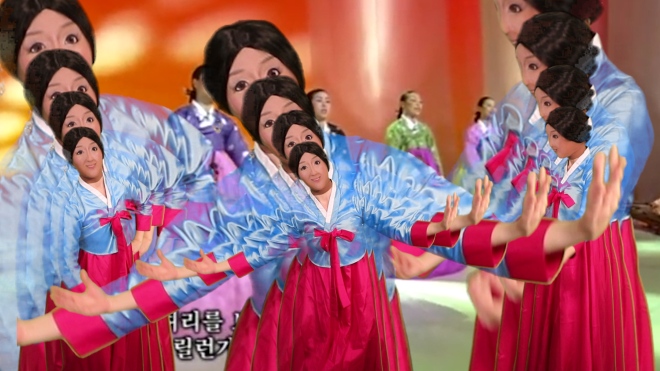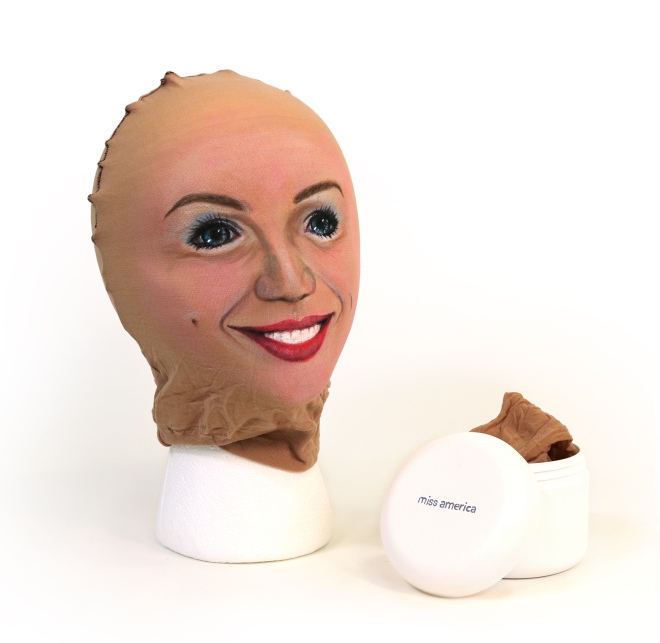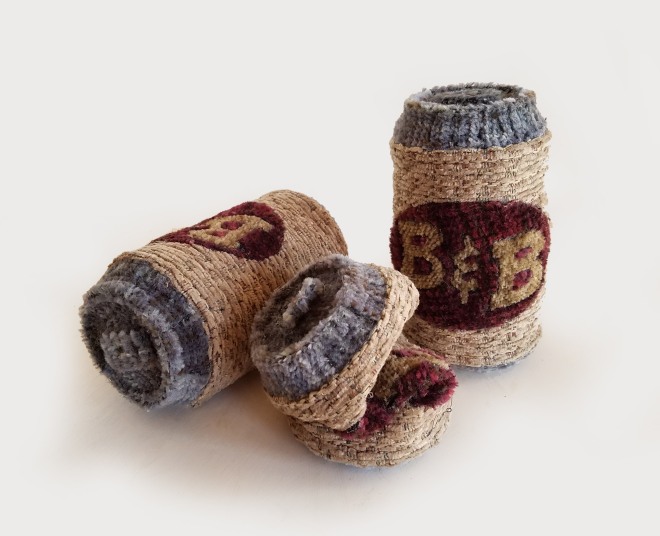SPRING/BREAK with Valery Jung Estabrook
Archived series ("Inactive feed" status)
When?
This feed was archived on October 30, 2022 11:52 (
Why? Inactive feed status. Our servers were unable to retrieve a valid podcast feed for a sustained period.
What now? You might be able to find a more up-to-date version using the search function. This series will no longer be checked for updates. If you believe this to be in error, please check if the publisher's feed link below is valid and contact support to request the feed be restored or if you have any other concerns about this.
Manage episode 184677525 series 1523403
by Til Will and Debbi Kenote
 Hometown Hero (Chink), Installation view, 2016.
Hometown Hero (Chink), Installation view, 2016.
In anticipation of SPRING/BREAK, we got in depth with Valery Jung Estabrook about her show, Hometown Hero (Chink)/ Thinly Worn. The show is currently on display on the 22nd floor at 4 Times Square, opening tonight from 5-9 pm, and on view through March 6.
Listen to the full interview:
https://openhouseblognyc.files.wordpress.com/2017/02/valery-estabrook-the-interview.mp3TIL WILL: This is Open House with Debbi Kenote and Til Will. We are here with Valery Jung Estabrook and we are really excited because we are going to be showing her work at SPRING/BREAK Art Show in Times Square. So we are going to ask her a few questions about her work, just to get a better idea of what we are dealing with, and so let’s get it started.
Can you tell us where you’re from and what goes on there?
VALERY JUNG ESTABROOK: I grew up in southwestern Virginia in a pretty rural area and it’s a very agricultural farming community. My parents are actually farmers, they have an orchard and I grew up on a farm. There’s also in my town, Lexington, Virginia, there’s also Washington Lee and Virginia Military Institute, so there’s a strong history there as well, specifically Civil War history.
TW: So you lived in New York [City] for 10 years and a lot of that time you were working in video production. How did that influence your work?
VJE: Well, it influenced my work because I got to be pretty much immersed in the commercial world for a very long time. And I was bombarded with pop-culture left and right, every single day. And having to understand how to influence people, via ads and visual communication…my job also involved a lot of research in terms of watching other tv, watching other films, watching other ads, lots and lots of TV ads. So I think it just kind of primed me for having this knowledge of lots of shiny, glossy imagery.
 Beautiful Face, Video Still, 2017. For sale at SPRING/BREAK.
Beautiful Face, Video Still, 2017. For sale at SPRING/BREAK.
DEBBI KENOTE: I like that. So diving into the work at SPRING/BREAK, can you talk about your re-purposing of the Confederate flag, and what it means to you with the history you just talked about.
VJE: So the Confederate flag is something that I, as a child, didn’t know what it was at first, but I saw it a lot. In school growing up, in Virginia, I attended public school and in the public curriculum you learn American history, and they always focus on Civil War history in particular, every single year, so pretty quickly on I realized what the history of it was. However, I personally believe that the history that was taught to me is a skewed perspective of history as far as how the Confederate cause is remembered contemporarily. So, It was something I knew was connected to the civil war and was always kind of presented to me as being historical and it wasn’t actually presented as something that should be considered inflammatory. It was pretty accepted where I’m from. I mean, not to say everyone loves it where I’m from, where I live, but it’s so commonplace that even if it does make you feel uncomfortable, which it makes me feel uncomfortable, even if it makes you feel uncomfortable it’s something that you get used to seeing.
 Hometown Hero (Chink) detail.
Hometown Hero (Chink) detail.
I have neighbors down the road from my parents house, that have a Confederate flag waving every single day of the year outside. I even had friends in highschool that at first I thought I wouldn’t get along with them, because they would wear confederate flags to school, and I would get to know them and there were some people that I would have considered friends in high school that definitely felt like it [Confederate flag] did not represent hate, they were of the argument that it was heritage, not hate. So it’s something where I was really always presented with the side of being empathetic for it, for the southern cause. But in a way, I truly believe it’s kind of…well…it’s sad, honestly. It’s sad, that’s what it is. Because it’s this nostalgia for something that doesn’t exist. It’s a nostalgia for something that people just need to let go of. You know, I understand that that area of the country and lots of towns and cities all over the country, you know not just my home town, but where ever there was Civil War history. I understand that history’s history and that you shouldn’t forget what happened, and that there was suffering, massive suffering, on the southern side. Huge devastation, I totally understand that, but I don’t think that just because that happened that we should revere a cause of one side and forget, or let that taint our perspective about what actually happened.
DK: That sort of leads into the next thing I was thinking about. You talked about the hate and the comfortability and the history, how did you interpret that into a domestic space for the installation?
VJE: When I was thinking about making the installation, well the impetus for it actually was the Dylann Roof shooting, having all the imagery of the Confederate flag being national news again really got me thinking about that and so it was definitely top-of-mind for a long time and emotional intense. And a lot of people from my hometown as well, on Facebook and social media, there were conversations and threads going on with people I had grown up with, talking about the Confederate flag. And in my hometown actually, there was an ad that had been taken out by one of the citizens that was defending the use of the Confederate flag and saying that from now on “democrats and black people were not allowed on his property” and “everyone needs to stop getting so upset about the Confederate flag” and you know he has this giant Confederate flag that’s waving out by the highway now…
Anyhow, so reading that was really heartbreaking for me, and so that was a reason why I started thinking about this. So as far as the installation, why I put it into a domestic space, I really was thinking about this idea of home. Because for me, when that news hit me, when I was talking with people from home and reading about the news from my hometown, I kept thinking about: this is my home, this is the closest thing I have to a hometown. Even though my mother’s not from that area, and my father’s not from that area, that’s where I grew up and that’s where my childhood memories are, and yet at the same time, when I go back to “home” there’s a certain feeling of discomfort that I’ll always have and I think I will always have, which is a weird feeling. I really envy a lot of the people I grew up with who can post online saying: “I’m back in Virginia, feels so great! It’s wonderful to see the mountains, what a beautiful place to live…” And it is beautiful, you know, it is great for me to go back “home,” but at the same time I always have this internal tension about what kind of encounter I’m going to have, because there’s always been, here and there, these little moments that make me feel like an outsider no matter what I do. That make me feel like my family will always be outsiders. No matter what, I will always be somewhat foreign in the eyes of the community. Maybe not my best friends, but definitely people who don’t know me personally, I think look at me and assume I don’t belong there sometimes.
TW: That actually leads really nicely into the next question I had for you, which is, how do think assumptions correlate to racism?
VJE: I think that racism is a big umbrella and assumptions are under that umbrella. What we assume and expect of people, that’s a certain kind of prejudice. It’s not always specifically race related, you know you can have expectations or assumptions of people based on anything, but I definitely think that when it comes to “how do you define racism” I think sometimes people get really defensive and say “I’m not racist,” because they don’t hate specifically other people of certain races, and it can be really frustrating as a person of color to try and say back: actually there are other kinds of racism, there are other things that are racist that aren’t necessarily just blatant hostility. There are just these viewpoints that we have, we have already decided who a person is when we see them, and I do believe that we all kind of do it a little bit. It’s instinctual, it’s tribal, it’s a human thing that’s kind of in the ‘lizard’ part of our brain. And that’s okay, it’s human, that’s another thing I wanna say: it’s ok to think certain things, what’s not ok is to let it go unchecked. The whole reason why we are here is that we are intelligent beings, we should be able to overcome those instinctual parts of our bodily reactions to other people and fears and that kind of thing.
 General Lee (pillow) an element of Hometown Hero (Chink), 2016
General Lee (pillow) an element of Hometown Hero (Chink), 2016
And so it’s not the immediate reaction thats wrong, its the course of action that happens after that assumption. You know, once that assumption is pointed out, there should be some kind of correction and self-awareness. Because again, if you are meeting a person who is different than you for the first time, different in a way that’s kind of new for you, you know…people are people, people are human. People make mistakes, I make mistakes, I’ve definitely judged certain people throughout my life. But, I think what it is, is to try to obviously be aware it’s happening and in the moment be aware of what you’re doing, or even after the fact realize what you’ve done and not do it again. Or to reach out to communities and figure out how to make sure you don’t keep doing things the same way, or keep yourself in that same mindset.
TW: Yea that’s a very nice way to go about answering that question.
DK: It Seems like empathy is an important tool.
VJE: Yea Empathy, although one thing I do think though, I was talking to Mike Cloud about this a lot. When he was my professor and when I was talking to him about the work when it was in its infancy, I was talking about how I would really like to reach out and let people who don’t have that experience empathize with that experience, and one thing that he pointed out to me that was really eye opening in the moment, was that he mentioned people who have never been oppressed can never really relate to what that experience is like either. And I think it was something I’d never really thought of and had this kind of idealized mission of my work to be like ‘now everyone can experience…’ but at the same time it’s not that people can experience. What it is, is trying to describe my personal experience and maybe there’s something within that, that a person can connect to.
TW: Right, right. And I think this is surrounding the idea that we were talking about last night. Well, it’s not really just an idea, it’s a fact, that Asian Americans are under-represented across the board. So, we talked a lot about cinema from the 80s and 90s and how that affected your childhood and the way that Asian American characters were portrayed. Can you talk about how that affected you and maybe how it drives your work?
VJE: Let’s see here, where do I start with that one… (laughter) It’s a really long and complicated answer. Well, I mean, for the longest time when I was a kid I only saw Asian Americans either being adult women who were sexual objects or docile sexual objects, or men who were math nerds. That’s kind of the only representation I ever got, and there were so few to begin with, it’s not like there were hundreds of these examples, there were maybe 5 characters in cinema or TV to point to at all. And I think that for me it’s something that I definitely encountered more as a developing person or a young adult. As a child, having to battle that. I think that at this point in my life it’s not something I’m not constantly struggling against because I feel confident with who I am and I don’t have to find that anymore. But when I was still trying to find that I felt like it influenced me because it influenced the people who were influencing me. It influenced what people offered to me: “maybe you should try calculus, maybe you should try this, maybe you should try science,” you know, “maybe you should try cello or piano” or those kinds of things and I felt like I really looked up to people of authority because I was taught to be this very dutiful person, so I really respected a lot of my teachers and people that were older than me and what they said. So if people said, “Oh, I think you’d be good in XYZ…” I tried what it is that they gave me. But, it wasn’t until I was maybe seventeen or eighteen that I realized that I had always wanted to go into the arts, and especially visual art, and I kind of knew that math and science… (laughter)…even though I do actually appreciate math and science and I do think science is really cool, I knew at that point in my life that I wanted to be an artist in some way, permanently.
 Crybaby, acrylic on nylon, plastic case, 2017.
Crybaby, acrylic on nylon, plastic case, 2017.
TW: Great. So we talked a little last night beforehand about one of these keywords that you’ve been addressing in your work, it’s ‘ariryang.’ What does that word mean to you?
VJE: So, ariryang is a word that comes from a Korean folk song. It’s a very famous Korean folk song, it’s kind of the quintessential national song of Korea, and for me it kind of embodies a lot of Korean feeling for me because my mother would sing the song a lot. Going around the house a lot I would hear her, and I would always ask what does it mean? And for her it had so much deep feeling of hope and sadness and suffering and it kind of just summed up for me–I don’t know if I was reading too much into it at the time–but maybe experiences that she had had, that she couldn’t really talk about. But maybe this song could in someway give expression to those feelings that were maybe old, or buried, or hidden. There were some things she couldn’t necessarily speak about openly. So for me it just always felt like this word that just encompassed my mother, I don’t know how else to say it. All those things that my mother doesn’t talk about that I know that she feels. So for me it’s always been this important word that connects me to her. And also, this is just a kind of funny side thing, but growing up on an orchard, my parents grow asian pears and one of the pear varieties is ariryang, and so that was always this dual meaning for me growing up. You know we have ariryang pears, and also ariryang is this really weighty heavy emotional thing too. And they’re also a delicious pear, so, I felt like it was a constant word in our household.
TW: So your piece Ariryang, which is a mask, what is that image from?
 Ariryang, acrylic on nylon, plastic case 2016.
Ariryang, acrylic on nylon, plastic case 2016.
VJE: So that’s actually a mask that the pattern for that is actually taken from these traditional masks that are used in plays and dances. The masks themselves are called Tal, and there are Talnori and Talchum, and those are the mask plays and masks dances. And they’re very old Korean types of performances and folk tradional things. And that specific mask was used to portray this very feminine coquette kind of character, and there are other masks too that kind of point to archetypal characters. And the plays that were put on were meant for normal people. When you put on these masks, then you could shed your identity and become those characters and in that it would give you freedom to criticize people in public, freedom to criticize the old woman or mayor of the town, or whatever…
TW: As theatre?
VJE: Yea as theatre.
TW: So it was like, deemed appropriate for doing those kinds of things, when you had these masks as part of an event….
VJE: Well it was inappropriate to talk disrespectfully without them, but when you had those masks you could do political satire if you wanted to. You had the freedom to say what you want, to be who you want, by occupying those characters.
DK: Great. So I wanted to get into, for the last couple questions, the current political climate. You seem to have a really elegant pairing of concept and medium in your work. I’m thinking in particular of your use of installation, video and painting among other things, and how you talk about domesticity, media, history and I’m curious as to if you think there’s a medium that is best suited to the current political climate?
VJE: (Laughter) That’s a loaded question, so I’m going to be very diplomatic and say that for me, personally, I find this current political climate we are in to be very unpredictable. I feel like every day there’s something else, that I have to get up to speed on. There’s a new event every day where I have to read an article or watch a video and figure out what else has changed. Because of that, video allows me I think to work a little more… to be on my feet about those kinds of things. I can kind of work through my thoughts quickly or at least faster than I would if I were painting. I also think that, to be completely honest, I don’t know how great of a painter I am…
 Miss America, acrylic on nylon, plastic case, 2017
Miss America, acrylic on nylon, plastic case, 2017
DK: You’re a good painter.
TW: Valery’s a great painter.
VJE: (laughter) Thanks. But I really enjoy painting. Painting to me feels very self-indulgent and video to me, you know, it’s a time based medium. So because of that I feel like I can take someone on a more narrative journey. And I really like that aspect about the medium. So as far as that, communicating something that is very specific is easier for me in video. Versus, in painting, I want to communicate something more abstract, as far as expression, or, you know, vague. But with video I feel like I can put a real message into it, and I think that’s important for political work.
DK: Yea, I definitely see what you mean. So, I wanted to end on a spoiler alert to the show…
VJE: Moonlight won last night…
(laughter)
DK: …Which is that you will be donating a portion of your SPRING/BREAK Art Show profits to the Southern Poverty Law Center, and I’m curious as to if you could explain why this is important to you.
VJE: Well, I think that the Southern Poverty Law Center does really great work and they’re fighting on the right side of the issues that really matter to me. They represent people in cases that involve civil rights, LGBTQ rights, women’s rights, and also immigration rights and so especially with right now, the current administration’s stance on immigration…it’s incredibly upsetting to me. Because I know people, I mean even if I didn’t know people it would be upsetting. There are definitely people that I care about who will be directly affected by this. And for me, you know that hits so close to home also because I’m a child of an immigrant. I have friends that are immigrants, I think we all have friends that are immigrants.
 Born N’ Bred Beer, 2016.
Born N’ Bred Beer, 2016.
DK: Certainly.
VJE: It’s just that people may not see it. You know, and may not choose to see it. And that’s what’s heartbreaking, when people don’t realize that, unless you are Native American, really every single person in this country came from an immigrant.
TW: Yup.
VJE: And so of course that’s been said so many times before but right now we are not really living up to the American ideals, the few that I believe in. Which is you know, to be a land that is accepting, where people can actually start again, and honestly I think that immigrants are the hardest working people, and the hardest among us, because they actually choose to be American, versus those of us that are arbitrarily born into it and choose to take it for granted. So yea, to be able to donate to an organization that can help that in some way, I think that’s really important, and obviously, if you’re able to, I think it’s very important to give.
TW: Some very wise words from Valery Jung Estabrook.
DK: Thank you very much!
TW: We are super excited, once again, to show Valery’s work at SPRING/BREAK Art Show, which opens TOMORROW! We are going to be at 4 Times Square…
DK: And our booth number is 2256, on the 22nd floor.
TW: So come by, see Valery’s work, buy Valery’s work, because, it’s where it’s at, really. Valery thanks so much for being with us. This has been a production of Open House, which is Debbi Kenote and Til Will (myself). Stay tuned!
For tickets to SPRING/BREAK click here
7 episodes




